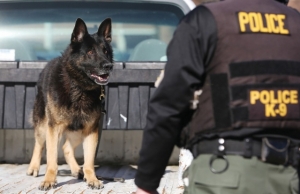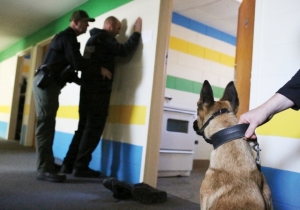Police work: K-9 training with GPD
By Joey Pitchford
Published in News on February 14, 2017 8:04 AM

News-Argus/CASEY MOZINGO
Officer Ryan Harrison takes a bite from K-9 Ghost during a training exercise with the Goldsboro Police Department on a trail off of the Stoney Creek Greenway Monday. Harrison volunteers his time to assist K-9 officers with their training. The federal government requires that they complete at least 16 hours of training to maintain certifications.

News-Argus/CASEY MOZINGO
K-9 Elivis holds on to the sleeve of a bite suit during a training exercise Monday morning. In addition to bite work, officers train the dogs to do drug and item searches.

News-Argus/CASEY MOZINGO
K-9 Kezna watches K-9 Officer Thomas Collins pat down Ryan Harrison during a training exercise McFarland Building where she was tracking a person hiding in a room.
For animals whose job may place them directly in harm's way, the dogs of the Goldsboro Police Department K-9 unit sure seem to enjoy what they do.
On Monday, officers from the K-9 unit took the three dogs, Ghost, Kezna and Elvis, through their paces in a full day of training exercises ranging from trailing runaway criminals to sniffing out illegal drugs.
Beginning around 8 a.m., the three dogs and their GPD handlers, officers Thomas Collins, Jason Erkes and Joe Kosuda, left to begin the day.
They started first at Wayne Community College, before relocating to a series of biking and walking trails near downtown Goldsboro.
The trails, located in a heavily wooded area, served as an ideal location for the dogs to practice trailing a scent.
From the initial staging area, the "bad guy" -- in this case officer Ryan Harrison -- moved further into the woods wearing a bite-resistant jacket, where he found a spot to hunker down and wait.
K-9 officers are selected early on based partly on their prey drive, which is the dog's natural instinct to hunt. Kosuda, who works with German shepherd Elvis, explained that, for the dogs, this kind of exercise is both work and play.
"It's a game to him," he said. "When he's biting or going after someone, he's not doing it with any anger or hate in him. It's just what he loves to do."
Once Harrison found his spot, he alerted the K-9 officers that he was ready. It wouldn't be long then before Ghost, a pure black German shepherd, was hot in pursuit of his scent.
Soon the dog had rounded the corner with Collins right behind him.
As soon as Ghost saw Harrison, it was clear he had only one goal in mind.
Standing between Harrison and Collins, Ghost barked at Harrison, who picked up a stick and waved it around like a weapon.
When Collins' orders to drop the weapon went unheeded, he released Ghost, who quickly covered the distance to Harrison and clamped down on his arm, dragging him to the ground for Collins to apprehend.
Harrison explained that a trained K-9 officer like Ghost is nearly impossible to dislodge once he has a hold on his target.
"Once he bites down, no matter what I do, he's not going to let go," he said. "I could basically drag him into this briar patch over here or start walking off with him on me, or hit him with a stick, and he wouldn't let go."
Kezna, a tan malinois, was up next. The fastest runner among the three K-9 officers, her task would include chasing down a fleeing Harrison after sniffing him out.
Hiding behind a concrete pillar down another nearby trail, Harrison explained how the exercise fit into the greater scheme of K-9 training.
"This is simulating the other side of how people respond to the dog," he said. "Either they'll give up when they see the dog, which is what happens 99 percent of the time, or they'll see the dog and take off and try to outrun it.
"I'll start running, and she'll catch me before I've made it 20 yards," he said.
It may have happened even sooner than that, as Kezna made a beeline for Harrison and brought him down by the arm within seconds.
The third and final dog to follow Harrison's trail was Elvis, the 8-year-old veteran of the team known for his strength and powerful bite.
His handler, Kosuda, talked about how distinctly the dog's personality changes when it is time to go to work.
"I usually give him a toy to distract him, I don't like to use the bite sleeve because he gets worked up when he sees it," he said. "He's a big teddy bear, but the second that bite sleeve comes out, he's a completely different animal."
That proved true when, after trailing Harrison down a path even further into the woods, Elvis nearly dragged him off his feet more than once.
As the day progressed, the dogs went through a variety of exercises designed to test their skills and composure. In a segment similar to the first bite training exercise, the officers introduced firearms loaded with blank rounds. The dogs, following their training, continued to advance on their targets even through the sounds of gunfire.
Another exercise saw the K-9 teams searching for Harrison and hidden drugs inside the abandoned McFarland building at the old Cherry Hospital. There, the dogs followed scents through the halls, pawing and barking at closed doors and cabinets when they had located their targets.
The officers used specially concocted drugs with no active ingredients to make sure the dogs got an authentic scent without being in danger should they accidentally ingest some of the material.
At the end of the day, like every day, the dogs go home with their handlers. Collins said that, while Ghost makes for a good companion at home, the dog's real love is for his work.
"When we're at home, Ghost does everything my wife or I tell him to do," he said. "But when it's time to go to work, when he sees me put on the uniform, he knows it's time to go. And he will not leave my side."
